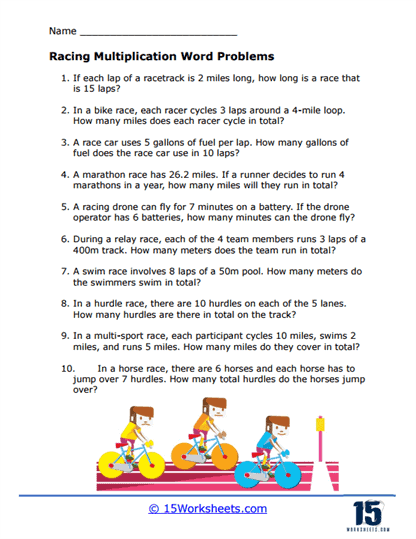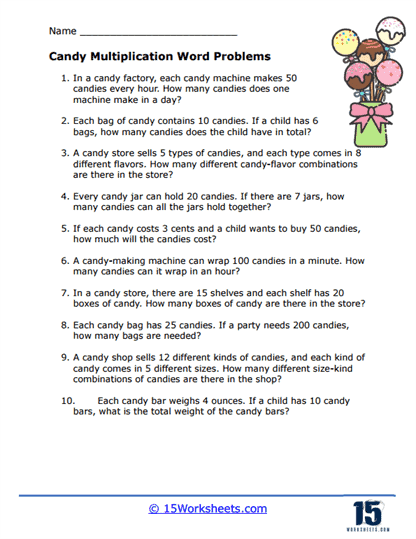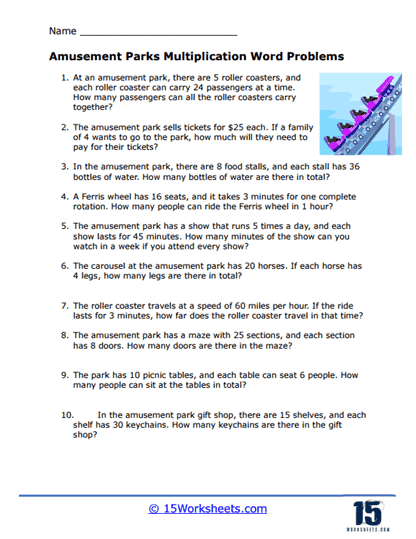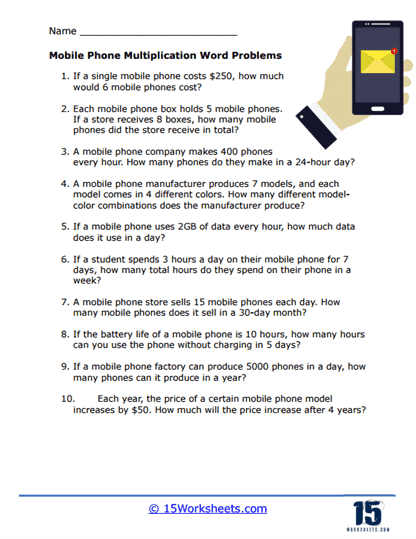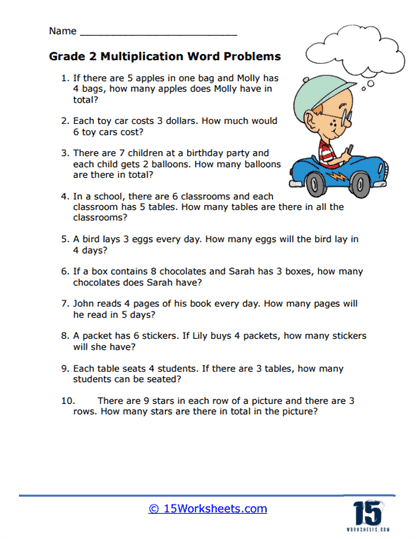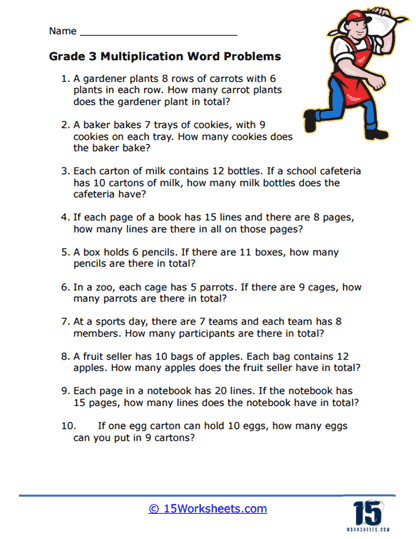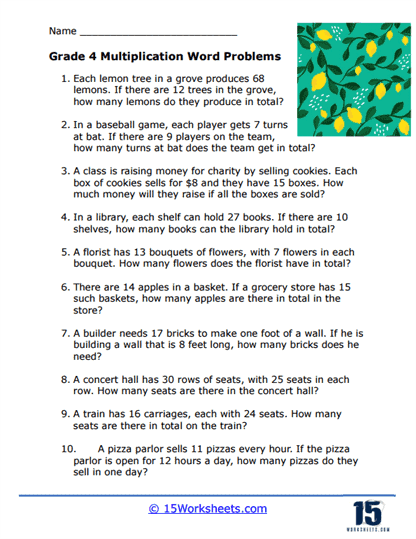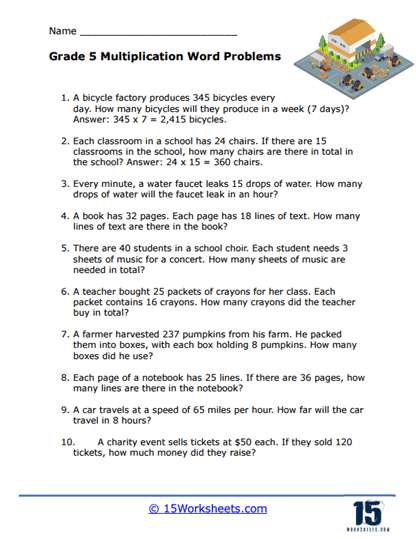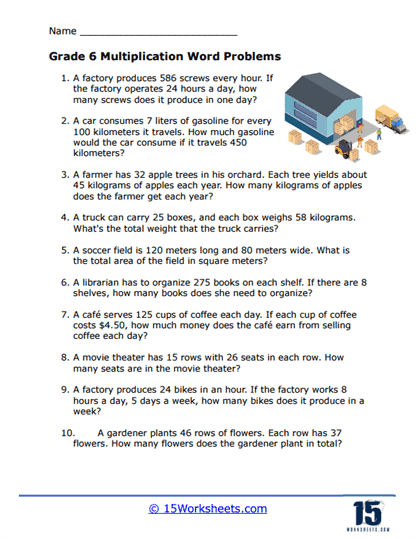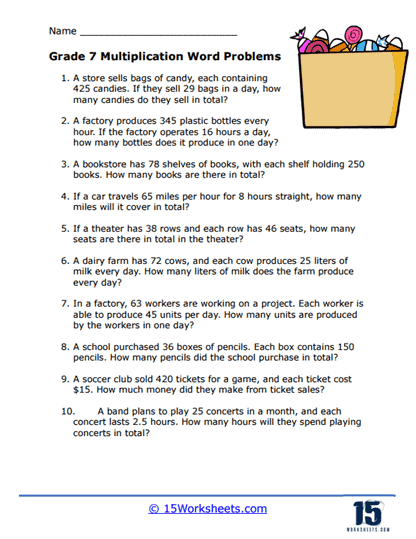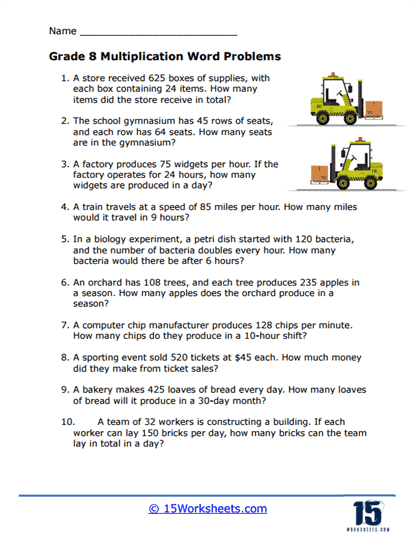Multiplication Word Problems Worksheets
What Are Multiplication Word Problems?
Multiplication word problems are mathematical problems that require you to apply multiplication operations to solve real-world scenarios or situations. In these problems, you are presented with a context or a story that involves quantities that need to be multiplied together to find a solution.
Multiplication word problems can involve various types of situations, such as equal groups, arrays, repeated addition, scaling, and proportional relationships. They require you to understand the problem, identify the relevant quantities, and perform the multiplication operation to find the answer.
By working through multiplication word problem worksheets, students not only strengthen their multiplication skills but also develop critical thinking and problem-solving abilities. They learn to apply mathematical principles to practical contexts, improving their ability to make calculations accurately and efficiently in everyday life.
Multiplication word problem worksheets are a valuable tool for educators to assess students’ comprehension of multiplication concepts and their ability to apply multiplication principles to real-life scenarios. These worksheets can be used in the classroom to reinforce lessons, as homework assignments, or as part of standardized test preparation to ensure students have a solid foundation in multiplication skills.
Example Multiplication Word Problems
Problem – Sally has 4 bags, and each bag contains 6 apples. How many apples does she have in total?
Solution – To find the total number of apples, you multiply the number of bags by the number of apples in each bag – 4 bags × 6 apples = 24 apples. Therefore, Sally has 24 apples in total.
Problem – A store sells shirts for $15 each. If Tom buys 5 shirts, how much does he spend in total?
Solution – To find the total cost, you multiply the price per shirt by the number of shirts – $15/shirt × 5 shirts = $75. Therefore, Tom spends $75 in total.
Problem – A box of cookies contains 10 cookies, and there are 8 boxes in a case. How many cookies are there in a case?
Solution – To find the total number of cookies in a case, you multiply the number of cookies in a box by the number of boxes – 10 cookies/box × 8 boxes = 80 cookies. Therefore, there are 80 cookies in a case.
Multiplication word problems can involve quantities of objects, items, groups, or measures. They may require you to find the total, determine the number of groups or items, calculate the cost, or solve for a missing quantity.
When solving multiplication word problems, it’s important to carefully read and understand the problem, identify the relevant quantities, and apply the multiplication operation correctly. Pay attention to units, labels, and any additional information provided in the problem statement. By breaking down the problem into its essential components and performing the multiplication correctly, you can find the solution to the word problem.
How to Identify When a Word Problem Calls for Multiplication
Identifying when a word problem calls for multiplication involves understanding the problem’s context and recognizing the relationships between the quantities involved. Here are some key strategies to help you identify when a word problem requires multiplication:
Look for repeated groups or equal-sized sets – Multiplication often comes into play when the problem involves distributing items into equal groups or sets. Phrases like “each,” “every,” “per,” “in each group,” or “in equal parts” are indicators that multiplication may be involved.
Identify situations that involve scaling or proportional relationships – Multiplication is commonly used when scaling up or down quantities or when working with proportional relationships. Phrases like “twice as,” “three times the,” “proportional to,” or “in direct proportion” suggest the need for multiplication.
Recognize arrays or arrangements – If the problem describes objects arranged in rows or columns, such as a rectangular grid or an array, multiplication is often required to determine the total number of objects. Arrays can be represented as rows × columns, which indicates the need for multiplication.
Pay attention to phrases that imply repeated addition – Multiplication is fundamentally related to repeated addition. Look for phrases like “added together,” “combined,” “total of,” or “in all,” especially when the quantities involved are equal or consistent. Multiplication allows you to efficiently perform repeated addition.
Consider situations involving area or volume – Problems that involve calculating the area of a rectangle, the volume of a box, or the total amount of space filled typically require multiplication. Area and volume are determined by multiplying the dimensions of the shape or container.
Analyze the question being asked – Look at the specific question or the information being sought in the problem. If it involves finding a total, calculating a cost, determining a product, or scaling quantities, multiplication is likely to be involved.
By applying these strategies, you can develop a better understanding of when multiplication is needed in word problems. Remember to carefully read the problem, identify the relevant quantities and relationships, and determine how multiplication can be applied to find the solution. Practice and familiarity with different types of word problems will help you become more adept at recognizing when multiplication is the appropriate operation to use.
When in the Real World Would We Need to Solve Multiplication Word Problems?
Multiplication word problems have practical applications in various real-world scenarios. Here are some examples of situations where solving multiplication word problems is commonly encountered:
Shopping and Finance – Multiplication word problems are frequently encountered when calculating total costs, determining discounts, calculating sales tax, or finding the total price of multiple items. For instance, calculating the total cost of groceries, determining the cost of multiple items with discounts, or finding the total price of a group of products.
Measurement and Scaling – When scaling measurements, such as enlarging or reducing dimensions of objects, multiplication is required. For example, in architecture or design, multiplying dimensions to scale up or down a blueprint or determining the total area or volume of a space or container.
Time and Distance – Multiplication word problems come into play when calculating rates, distances, or durations. For instance, determining the total distance traveled given a constant speed and time or calculating the total time required to complete multiple tasks with the same duration.
Cooking and Recipes – In the culinary world, multiplication word problems are encountered when scaling recipes to serve more people, calculating ingredient quantities based on desired servings, or determining the total amounts of ingredients needed for a specific number of dishes.
Sports and Fitness – Multiplication word problems are used in sports and fitness contexts to calculate scores, statistics, or performance metrics. For example, determining the total points scored by a team in a series of games or calculating the total distance covered during a workout session.
Manufacturing and Production – Multiplication is essential in manufacturing and production processes when calculating quantities, rates, or costs. For example, determining the total production cost by multiplying the cost per unit by the number of units manufactured or calculating the total number of products based on the production rate.
Gardening and Landscaping – Multiplication word problems arise in gardening and landscaping when calculating areas, quantities of plants, or estimating materials. For instance, determining the total area to be covered with sod or calculating the number of plants needed for a given area.
Financial Investments – In finance and investment scenarios, multiplication word problems come into play when calculating compound interest, investment returns, or portfolio growth over time. For example, determining the total value of an investment by multiplying the initial investment amount by the growth rate.
Inventory and Stock Management – Multiplication is used in inventory and stock management to calculate the total value of inventory, determine order quantities based on sales rates, or estimate revenue based on unit prices and quantities sold.
Engineering and Construction – In engineering and construction fields, multiplication word problems are encountered when calculating dimensions, quantities, costs, or material requirements. For instance, determining the total cost of construction materials by multiplying the unit cost by the required quantity.
These examples illustrate how multiplication word problems are relevant in various aspects of everyday life, from shopping and cooking to finance, manufacturing, and construction. The ability to solve multiplication word problems is valuable in making accurate calculations, managing resources, and making informed decisions in numerous practical situations.



